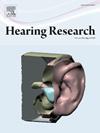探索电诱发复合动作电位在前庭-耳蜗植入中的应用
IF 2.5
2区 医学
Q1 AUDIOLOGY & SPEECH-LANGUAGE PATHOLOGY
引用次数: 0
摘要
目的:前庭人工耳蜗植入是治疗前庭功能丧失的一种有潜力的方法。一个关键的方面是制定可靠和客观的结果测量,以评估其功效并优化其性能。与人工耳蜗护理和其他神经修复一样,电诱发复合动作电位(eCAP)可以用来测量神经对人工耳蜗刺激的反应。ecap可能提供有关电诱发前庭-眼反射的存在和错位以及潜在的前庭-耳蜗相互作用的信息。这在术中功能评估,作为拟合的输入,以及测量兴奋的扩散方面是有价值的。本研究旨在探讨ecap在前庭-耳蜗植入研究中的潜在作用。对10名前庭人工耳蜗植入者进行designecap测量。采用不同的配置,即经耳、前庭-耳蜗和耳蜗-前庭。ecap的预测价值评估了四个结果:电诱发的前庭-眼反射(eVOR)的存在,eVOR的不对齐程度,前庭刺激引起的听觉感知,以及耳蜗刺激引起的前庭激活的患病率。结果eCAP对eVOR的阳性预测值较高(1.0),阴性预测值较低(0.54)。经管eCAP的存在与eVOR的错位程度不一致。此外,听觉感知的预测值较低(即≤0.5)。eCAP记录的耳蜗与前庭结构表明耳蜗与前庭相互作用的可能性很高(即67%的电极)。结论前庭eCAP的存在可以预测eVOR的存在。然而,较低的阴性预测值使eCAP不能作为术中电极位置评估的可靠指标。前庭-耳蜗配置的eCAP测量表明,在前庭和耳蜗电极的临床拟合范围内的刺激水平下,耳蜗和耳蜗管道之间的兴奋传播已经是可能的。测量到的ecap与eVOR的错位或前庭刺激导致的听觉感知不一致。未来的研究需要阐明前庭-人工耳蜗eCAP测量的全部潜力。本文章由计算机程序翻译,如有差异,请以英文原文为准。
Exploring applications of electrically evoked compound action potentials using the vestibulo-cochlear implant
Objectives
Vestibulo-cochlear implants are a potential treatment approach for patients with loss of vestibular function. A critical aspect is the development of reliable and objective outcome measures, to assess their efficacy and optimize their performance. As in cochlear implant care and other neural prostheses, electrically evoked compound action potentials (eCAP) can be used to measure the neural response to implant stimulation. eCAPs might provide information about the presence and misalignment of the electrically evoked vestibulo-ocular reflex, and potential vestibulo-cochlear interactions. This could be valuable in intra-operative functionality assessment, as input for fitting, and to measure spread of excitation. This study aimed to explore the potential role of eCAPs in vestibulo-cochlear implant research.
Design
eCAPs were measured in ten subjects with a vestibulo-cochlear implant. Different configurations were used, i.e., trans-canal, vestibulo-cochlear and cochleo-vestibular. The predictive value of eCAPs was evaluated for four outcomes: presence of an electrically evoked vestibulo-ocular reflex (eVOR), degree of misalignment of the eVOR, auditory perception due to vestibular stimulation, and the prevalence of vestibular activation due to cochlear stimulation.
Results
The results demonstrated a high positive predictive value of the eCAP for the presence of an eVOR (i.e., 1.0), while the negative predictive value was low (i.e., 0.54). The presence of trans-canal eCAP did not correspond with the degree of misalignment in the eVOR. Furthermore, the predictive values for auditory perception were low (i.e., ≤0.5). eCAP recordings in the cochlea to vestibular configuration imply a high likelihood of cochlear to vestibular interaction (i.e., 67% of electrodes).
Conclusions
The presence of a vestibular eCAP was demonstrated to be a predictor of the presence of the eVOR. However, the low negative predictive value prevents the eCAP from providing a reliable indicator for intra-operative electrode position evaluation. eCAP measurements in vestibulo-cochlear configurations indicated that spread of excitation between the cochlea and canals is already possible at stimulation levels within the clinical fitting range of both the vestibular and cochlear electrodes. Measured eCAPs did not correspond with misalignment of the eVOR or the presence of an auditory percept as result of vestibular stimulation. Future research is needed to elucidate the full potential of vestibulo-cochlear implant eCAP measurements.
求助全文
通过发布文献求助,成功后即可免费获取论文全文。
去求助
来源期刊

Hearing Research
医学-耳鼻喉科学
CiteScore
5.30
自引率
14.30%
发文量
163
审稿时长
75 days
期刊介绍:
The aim of the journal is to provide a forum for papers concerned with basic peripheral and central auditory mechanisms. Emphasis is on experimental and clinical studies, but theoretical and methodological papers will also be considered. The journal publishes original research papers, review and mini- review articles, rapid communications, method/protocol and perspective articles.
Papers submitted should deal with auditory anatomy, physiology, psychophysics, imaging, modeling and behavioural studies in animals and humans, as well as hearing aids and cochlear implants. Papers dealing with the vestibular system are also considered for publication. Papers on comparative aspects of hearing and on effects of drugs and environmental contaminants on hearing function will also be considered. Clinical papers will be accepted when they contribute to the understanding of normal and pathological hearing functions.
 求助内容:
求助内容: 应助结果提醒方式:
应助结果提醒方式:


